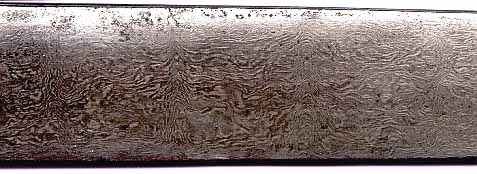

Details of the blade of a Kurdish dagger (mountings early 20th Century), cut down from a Persian shamshir, signed Kalb Ali (dated middle to late 18th Century) A 60kb jpeg close-up of this blade may also be viewed to more clearly see the Mohammed's ladder pattern. These blades are directly forged from a small cake of heterogeneous steely iron which traditionally was produced in India. The steel, which is called wootz, was produced by heating iron ore, charcoal, and vegetable matter in a crucible for a prolonged period of time. This would produce a fairly high carbon steel, indeed sufficiently high carbon that special handling was necessary in forging the blade if fractures were to be avoided. The above close-up of such a blade shows a wavy pattern of shiny and dark steel. These patterns are made up of networks of steel showing different metallographic structures (globular cementite in a matrix of pearlite per Maryon (1960)) and extend through the full thickness of the blade. J.D. Verhoeven, et. al. (1998) propose that carbide forming trace impurities in the source ore and special forging and heat treatment techniques are necessary to preserve and enhance the pattern. The pattern is exposed when final grinding occurs and the natural heterogeneity of the steel is exposed. Customers for sword blades in the Middle East reputedly particularly valued a type of pattern referred to as kirk narduban or the ladder of the Prophet. In the close-up photograph above, you can see several "rungs" of such a ladder which are alterations in the background pattern running perpendicular to the length of the blade. While many explanations have been put forth in the literature for how this was difficult to achieve, a simple solution discovered by modern bladesmiths is that such a pattern is achievable by the mechanical manipulation of filing notches into the incomplete blade perpendicular to its length at regular intervals before final forging; essentially the same technique by which activity can be added to the pamor of the Javanese keris, again producing an alteration analogous to geographical contour lines.
<Return to previous part ~ Return to the Table of Contents ^ ~ Go to next part >